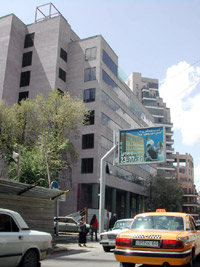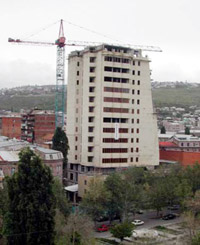
Yerevan is Being Built to Suit Investors' Tastes
Around 15 years ago, the process of new, fundamental changes in the Armenian capital Yerevan was begun. The changes began without a finalized master plan. The city was built part by part, piece by piece, for the benefit of one individual or another, according to his or her taste and design. How is the new Yerevan being built? Who is building it? Before independence, this question would seem absurd. Even schoolchildren knew that Yerevan was being built in lovely pink, and that the Soviet government was building it. Today the answer is very different - Yerevan is being built in the colors chosen by individual investors and anybody who has the means to buy land and finance construction can end up being the builder.
The last master plan for Yerevan was finalized in 1971 but was quickly deemed to have lost importance and laid aside. The next master plan, the sixth so far, was established a lot later, in 2006.
The head of the working group for the new plan and Yerevan Project director, Gurgen Musheghyan, assessed 15 years of silence negatively: "We shouldn't have had this new plan after 15 years, when we've already become a market economy. Rather, these fundamental issues should have been settled from the very first day so that the city could develop in one direction or the other. For example, before independence, Yerevan did not have a diplomatic community as large as this, or a banking system like the one we have now - we need to make space for everyone."
According to the new plan, any construction in Yerevan must be done in territory earmarked for the city itself. In other words, the plan outlines Yerevan's development only within the 22,000 hectares of its administrative territory. The new high-rise buildings in construction seem to reflect this part of the plan and the direction in which the capital is developing is upwards. The architectural style and whether or not they conform to standards in engineering is all decided by one person - the investor. The new motto going around is "the investor is always right", and that is the logic behind the construction, and reconstruction, of the new Yerevan.
"Had there been no Medicis, there would have been no Michelangelo, because architecture is not free art, it is always a response to public demand. An individual can also make the demand - if he is tasteless and knows nothing about art, then obviously the resulting work will also be tasteless," said architect Levon Vardanyan.
Modern builders are trying to design their own milieu. But this is being done at the expense of another environment. A new class of investor-builders has begun to emerge. For this social group, architecture is attractive because it provides the opportunity for lucrative business. Thus, it has become very important to construct buildings which will bring quick profit, in prestigious parts of the capital, especially the city center. This is why central Yerevan is now crowded with new residential buildings.
The influence of business on architecture is most obvious in the examples of Hyusisayin (Northern) and Glkhavor (Main) Avenues.
Construction in both of these cases began before the new master plan was finalized.
Levon Vardanyan evaluated Hyusisayin Avenue as follows: "It became simply a collection of residential buildings. The width of the street and structures' height do not conform - it is too narrow, but the buildings are very tall. The first floors are all built for public utilities, but why add so many residential floors? Because they are to be sold, and so the city center is being needlessly crowded with buildings. There is also the issue of underground urbanization. Even two underground floors are deemed too little. Every new building constructed in the city center must also use up underground space."
 |
 |
Narek Sargsyan, Yerevan's Head Architect, naturally did not agree. "It is wrong to judge based on a few buildings on Tumanyan Street today. It should be finished. Then you can decide only when you walk on those streets."
The shortcomings of new buildings usually surface later, when the time comes to serve the public. This service includes organizing transport routes, leisure areas and public safety.
The transport network in the center of Yerevan has been the capital's weak point since Soviet times. The last plan in 1971 envisaged the construction of highways circumventing the city center. But even then the emphasis was on residential buildings, and no highways were built.
In 2006, the working group for the master plan has once again focused attention on this problem. Three new highways circumventing the city center have been planned. The other major undertaking in the center of the capital is the construction of Glkhavor Avenue. According to Tamanyan's vision of the city, this was to be one of the central roads in the city. Completing a ring road in the plan, it was then supposed to be directed toward the Hrazdan Gorge. The road is to stretch from Saryan Street to the statue of Vardan Mamikonyan. This area is seen as a total green zone or a boulevard. However, the decision maker behind Glkhavor Avenue is once again an individual investor. The government, as organizer or supervisor, is either absent or conforms to the interests of the investor.
Today a number of residential buildings are being constructed on Glkhavor Avenue although a complete plan has yet to be developed. Investors do not want to fall behind the times. And construction plans are made to suit the current situation. This has been the case in the past. Needless haste and the willingness to cut corners for greater profit endanger not only Yerevan's architectural design but also the physical safety of its residents. Neglecting certain architectural norms could result in a major tragedy, especially for a city in a seismic zone, like Yerevan. Living in the center of the capital today is not just uncomfortable today, it is also dangerous.
Constructor Karo Ayvazyan had the following explanation, "There is a Yellow Lines concept in architecture. Buildings need to be spaced from each other at a distance equal to their heights. These norms are being ignored." Architect Levon Vardanyan said, "In developed countries, residential areas are usually located outside the city center, in suburbs where there is greenery and comfort, while the center is used mainly as office space. Here everyone wants to live in the center, for some reason. Soon people will realize that the center, Northern Avenue for example, is no place to live."
This modern construction suggests that the center of Yerevan is being subjected to radical changes. None of the constructors knows what the end result will be.
150 years ago, Ivan Chopin, the President of the Government of Profits and Court Assets for the "Armenian Province" of Czarist Russia, described Yerevan in this way, "The gardens facing the houses do not have trees in proper rows, nor are there decent streets on which to walk. The only thing on the landlord's mind is how to make more money. No thought has been given to comfort or to a suitable promenade."
Yerevan is the same today.
Anna Sargsyan
 Videos
Videos Photos
Photos
Write a comment